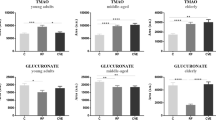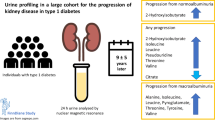Abstract
The study of two different Italian isolated populations was combined with a metabonomic approach to better understand tubular handling of amino acids. Levels of amino acids and metabolites have been analyzed by Nucleic Magnetic Resonance and expressed as ratio vs urinary creatinine concentration (mmol/mol). For most of the amino acids there is an age-related U shape pattern of excretion, with the peaks during childhood and old age, and a significant reduction in the adult age. Hierarchical cluster analysis has clearly identified three groups clustering the same amino acids: His, Thr and Ala (group one); Gly and Phe (group two) and a third larger one. Results have been further confirmed by factor and regression analysis, and used to confirm and, in some cases, infer new amino acids networks. As a matter of facts, the identification of strong evidences for clustering of urine excretion of several neutral amino acids suggests the predominant impact of relevant and common transporters




Similar content being viewed by others
References
Baylis C, Schmidt R (1996) The aging glomerulus. Semin Nephrol 16:265–276
Bohmer C, Broer A, Munzinger M, Kowalczuk S, Rasko JE, Lang F, Broer S (2005) Characterization of mouse amino acid transporter B0AT1 (slc6a19). Biochem J 389:745–751
Borsani G, Bassi MT, Sperandeo MP, De Grandi A, Buoninconti A, Riboni M, Manzoni M, Incerti B, Pepe A, Andria G, Ballabio A, Sebastio G (1999) SLC7A7, encoding a putative permease-related protein, is mutated in patients with lysinuric protein intolerance. Nat Genet 21:297–301
Broer A, Brookes N, Ganapathy V, Dimmer KS, Wagner CA, Lang F, Broer S (1999) The astroglial ASCT2 amino acid transporter as a mediator of glutamine efflux. J Neurochem 73:2184–2194
Broer A, Cavanaugh JA, Rasko JE, Broer S (2006) The molecular basis of neutral aminoacidurias. Pflugers Arch 451:511–517
Calonge MJ, Gasparini P, Chillaron J, Chillon M, Gallucci M, Rousaud F, Zelante L, Testar X, Dallapiccola B, Di Silverio F et al (1994) Cystinuria caused by mutations in rBAT, a gene involved in the transport of cystine. Nat Genet 6:420–425
Danilczyk U, Sarao R, Remy C, Benabbas C, Stange G, Richter A, Arya S, Pospisilik JA, Singer D, Camargo SM, Makrides V, Ramadan T, Verrey F, Wagner CA, Penninger JM (2006) Essential role for collectrin in renal amino acid transport. Nature 444:1088–1091
Feliubadalo L, Arbones ML, Manas S, Chillaron J, Visa J, Rodes M, Rousaud F, Zorzano A, Palacin M, Nunes V (2003) Slc7a9-deficient mice develop cystinuria non-I and cystine urolithiasis. Hum Mol Genet 12:2097–2108
Feliubadalo L, Font M, Purroy J, Rousaud F, Estivill X, Nunes V, Golomb E, Centola M, Aksentijevich I, Kreiss Y, Goldman B, Pras M, Kastner DL, Pras E, Gasparini P, Bisceglia L, Beccia E, Gallucci M, de Sanctis L, Ponzone A, Rizzoni GF, Zelante L, Bassi MT, George AL Jr, Manzoni M, De Grandi A, Riboni M, Endsley JK, Ballabio A, Borsani G, Reig N, Fernandez E, Estevez R, Pineda M, Torrents D, Camps M, Lloberas J, Zorzano A, Palacin M (1999) Non-type I cystinuria caused by mutations in SLC7A9, encoding a subunit (bo, + AT) of rBAT. Nat Genet 23:52–57
Fernandez E, Torrents D, Chillaron J, Martin Del Rio R, Zorzano A, Palacin M (2003) Basolateral LAT-2 has a major role in the transepithelial flux of L-cystine in the renal proximal tubule cell line OK. J Am Soc Nephrol 14:837–847
Harnevik L, Hoppe A, Soderkvist P (2006) SLC7A9 cDNA cloning and mutational analysis of SLC3A1 and SLC7A9 in canine cystinuria. Mamm Genome 17:769–776
Kleta R, Romeo E, Ristic Z, Ohura T, Stuart C, Arcos-Burgos M, Dave MH, Wagner CA, Camargo SR, Inoue S, Matsuura N, Helip-Wooley A, Bockenhauer D, Warth R, Bernardini I, Visser G, Eggermann T, Lee P, Chairoungdua A, Jutabha P, Babu E, Nilwarangkoon S, Anzai N, Kanai Y, Verrey F, Gahl WA, Koizumi A (2004) Mutations in SLC6A19, encoding B0AT1, cause Hartnup disorder. Nat Genet 36:999–1002
Mant D, Fowler G (1990) Urine analysis for glucose and protein: are the requirements of the new contract sensible? BMJ 300:1053–1055
Palacin M, Estevez R, Bertran J, Zorzano A (1998) Molecular biology of mammalian plasma membrane amino acid transporters. Physiol Rev 78:969–1054
Parvy P, Bardet J, Rabier D, Kamoun P (1995) A scheme for the interpretation of primary and secondary disturbances of plasma and urinary amino acid profiles. A possible way to an expert system. Clin Chim Acta 235:1–10
Peghini P, Janzen J, Stoffel W (1997) Glutamate transporter EAAC-1-deficient mice develop dicarboxylic aminoaciduria and behavioral abnormalities but no neurodegeneration. EMBO J 16:3822–3832
Peters T, Thaete C, Wolf S, Popp A, Sedlmeier R, Grosse J, Nehls MC, Russ A, Schlueter V (2003) A mouse model for cystinuria type I. Hum Mol Genet 12:2109–2120
Pilia G, Chen WM, Scuteri A, Orru M, Albai G, Dei M, Lai S, Usala G, Lai M, Loi P, Mameli C, Vacca L, Deiana M, Olla N, Masala M, Cao A, Najjar SS, Terracciano A, Nedorezov T, Sharov A, Zonderman AB, Abecasis GR, Costa P, Lakatta E, Schlessinger D (2006) Heritability of cardiovascular and personality traits in 6, 148 Sardinians. PLoS Genet 2:e132
Pineda M, Fernandez E, Torrents D, Estevez R, Lopez C, Camps M, Lloberas J, Zorzano A, Palacin M (1999) Identification of a membrane protein, LAT-2, that Co-expresses with 4F2 heavy chain, an L-type amino acid transport activity with broad specificity for small and large zwitterionic amino acids. J Biol Chem 274:19738–19744
Pinho MJ, Pinto V, Serrão MP, Jose PA, Soares-da-Silva P (2007) Underexpression of the Na + -dependent neutral amino acid transporter ASCT2 in the spontaneously hypertensive rat kidney. Am J Physiol Regul Integr Comp Physiol 293:R538–R547
Quan H, Athirakul K, Wetsel WC, Torres GE, Stevens R, Chen YT, Coffman TM, Caron MG (2004) Hypertension and impaired glycine handling in mice lacking the orphan transporter XT2. Mol Cell Biol 24:4166–4173
Ramadan T, Camargo SM, Herzog B, Bordin M, Pos KM, Verrey F (2007) Recycling of aromatic amino acids via TAT1 allows efflux of neutral amino acids via LAT2–4F2hc exchanger. Pflugers Arch 454:507–516
Risch NJ (2000) Searching for genetic determinants in the new millennium. Nature 405:847–856
Segawa H, Fukasawa Y, Miyamoto K, Takeda E, Endou H, Kanai Y (1999) Identification and functional characterization of a Na + -independent neutral amino acid transporter with broad substrate selectivity. J Biol Chem 274:19745–19751
Seow HF, Broer S, Broer A, Bailey CG, Potter SJ, Cavanaugh JA, Rasko JE (2004) Hartnup disorder is caused by mutations in the gene encoding the neutral amino acid transporter SLC6A19. Nat Genet 36:1003–1007
Torrents D, Mykkanen J, Pineda M, Feliubadalo L, Estevez R, de Cid R, Sanjurjo P, Zorzano A, Nunes V, Huoponen K, Reinikainen A, Simell O, Savontaus ML, Aula P, Palacin M (1999) Identification of SLC7A7, encoding y + LAT-1, as the lysinuric protein intolerance gene. Nat Genet 21:293–296
Varilo T, Peltonen L (2004) Isolates and their potential use in complex gene mapping efforts. Curr Opin Genet Dev 14:316–323
Acknowledgments
We would like to thank Carlantino and Stoccareddo populations for having participated to the study. We thank Antonella Ferrara for her technical assistance in providing pedigrees for Carlantino population and Dr. Ludovico Pontoni for his skillful cooperation in running NMR spectra and handling of NMR data. Work at least in part funded by the following grants: FP6-EUGINDAT (to all), Italian Ministry of Health (to PG), Regione Veneto, Giunta Regionale-Ricerca Sanitaria Finalizzata n.176/04, Venice, Italy (to HU and AG), the Spanish Project MEC BFU2006-14600- C02-01-02/BMC (to NV and PM).
Author information
Authors and Affiliations
Corresponding author
Rights and permissions
About this article
Cite this article
D’Adamo, P., Ulivi, S., Beneduci, A. et al. Metabonomics and population studies: age-related amino acids excretion and inferring networks through the study of urine samples in two Italian isolated populations. Amino Acids 38, 65–73 (2010). https://doi.org/10.1007/s00726-008-0205-8
Received:
Accepted:
Published:
Issue Date:
DOI: https://doi.org/10.1007/s00726-008-0205-8




